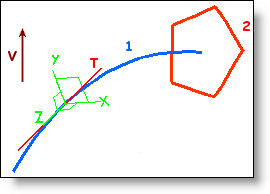
1: Path
2: Section
XYZ: Sweep frame
T: Tangent to the path on the origin of the sweep frame
V: Vertical direction
|
|
Swept - "Section alignment" option |
This option available in the Swept function allows you to define the manner in which the sections travel the path.
To define the orientation of the section along its entire movement on the path, TopSolid uses a frame that will follow the section.
In order to define the movement of the sweeping exactly, the simplest way consists of considering the section as being stationary on a frame of which the origin moves along the path. This frame will be called "sweep frame".
|
|
1: Path
2: Section
XYZ: Sweep frame
T: Tangent to the path on the origin of the sweep frame
V: Vertical direction
|
You can define the sweep frame in different ways; this allows you to obtain several types of geometries.
There are three alignment modes:
Normal
Vertical
Parallel
Normal:
In the NORMAL mode, the sweep frame is defined in the following manner:
|
|
Z is opposite T ( Z = -T )
X is orthogonal to T and V ( X = T ^ V )
Y is orthogonal to X and Z ( Y = Z ^ X )
|
This mode is used the most, since the section is a planar profile situated in the XY plane of the initial sweep frame, it will remain in the plane normal to the path during the entire sweeping, a shape with a constant section is thus obtained.
Vertical:
In the VERTICAL mode, the sweep frame is defined in the following manner:
|
|
Y is equal to V ( Y = V )
X is orthogonal to T and V ( X = T ^ V )
Z is orthogonal to X and Y ( Z = X ^ Y )
|
This mode is very handy for making drafts because if the section is a line in the XY plane of the sweep frame, making a given angle with Y, then the line will keep this angle in relation to the vertical direction during sweeping.
Parallel:
In the PARALLEL mode, the sweep frame has a constant orientation: the section is simply translated along the path.
|
|
|